Fishing for rainbow trout in Alaska is an unforgettable experience, but the presence of salmon changes the game entirely. When anglers first experience rainbow trout fishing in Alaska, they often feel like they’ve stepped into an entirely different sport. The rainbows here are bigger, more aggressive, and behave in ways that would seem alien to those accustomed to spring creeks in Montana or tailwaters in Colorado. The difference comes down to one transformative factor: Pacific salmon.
The Salmon-Fueled Ecosystem
In waters without salmon runs, rainbow trout are opportunistic feeders that rely on aquatic insects, small fish, and whatever else the stream provides year-round. These fish grow steadily but modestly on a relatively consistent diet. Alaska’s rainbow trout, however, live in a feast-or-famine world dictated entirely by the life cycle of five species of Pacific salmon.
Every summer and fall, millions of salmon return to Alaska’s rivers to spawn and die. This annual migration represents the largest single nutrient transfer from ocean to freshwater in the world. When salmon dig their redds and deposit eggs, when they die and decompose, they create a biological explosion that feeds everything from bears to birds to the rainbow trout waiting downstream.
The Insect Life That Gets Overshadowed
Alaska’s rivers do support populations of aquatic insects—stoneflies, caddis, mayflies, and midges all thrive here. In fact, the nutrient boost from decomposing salmon actually enhances insect populations. Studies have shown that streams with salmon runs produce significantly more aquatic insect biomass than comparable streams without salmon.
The irony is that despite this abundance, insects become almost irrelevant to the fishing experience for most of the season. A river might have excellent caddis hatches in July, robust stonefly populations year-round, and reliable mayfly emergences in August. But when millions of bright orange salmon eggs are drifting through the current, rainbow trout simply ignore the insects.
It’s not that the bugs aren’t there—they’re just utterly overshadowed by the caloric density and availability of salmon-related food sources. A rainbow trout can eat hundreds of salmon eggs in an hour of feeding, each egg providing far more protein and fat than dozens of mayflies. From a pure survival and growth standpoint, the choice is obvious.
Size Matters: Alaska Rainbows Are Built Different
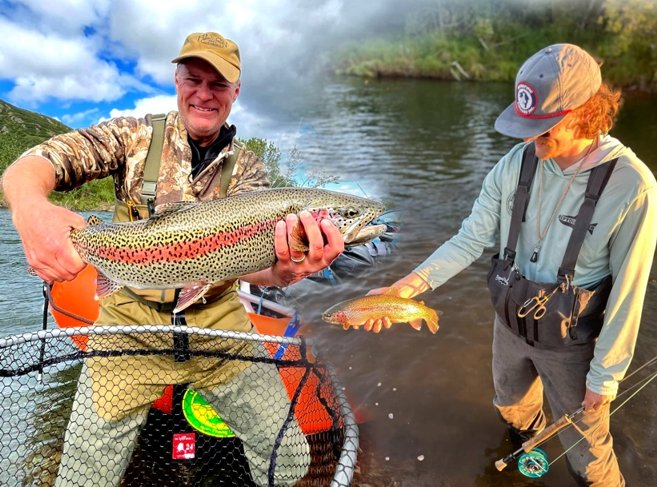
The most obvious difference any angler notices is size. In the lower 48 states, a 20-inch rainbow is a trophy worth celebrating. In Alaska’s premier rainbow waters, 20-inchers are common, and fish exceeding 30 inches are caught with surprising regularity.
This dramatic size difference stems directly from nutrition. Alaska rainbows gorge themselves on salmon eggs, salmon flesh, and the abundance of smaller fish attracted to the salmon runs. A single rainbow trout can consume hundreds of salmon eggs in a day during peak runs. This protein-rich diet allows them to pack on weight at rates impossible in typical trout streams. Where a rainbow in Pennsylvania might gain a few ounces per year, an Alaska rainbow can gain several pounds in a single season when conditions are favorable.
Seasonal Patterns: Following the Salmon Calendar
In non-salmon waters, rainbow trout fishing remains relatively consistent throughout the season, with hatches and water conditions creating the main variables. Alaska rainbow fishing, by contrast, revolves entirely around the salmon spawn calendar, creating distinct fishing windows.
June through Early July: This is the lean time. Sockeye and king salmon are entering the rivers, but haven’t spawned yet. Rainbows are feeding on resident food sources and are at their hungriest. Ironically, this can produce excellent dry fly fishing, as the trout behave more like their lower-48 cousins.
This pre-spawn window is when Alaska actually fishes like a traditional trout stream. Caddis patterns—Elk Hair Caddis, X-Caddis, and Goddard Caddis in sizes 12-16—can be highly effective during evening hatches. Stonefly nymphs, particularly Kaufmann’s Stones and Pat’s Rubberlegs in black or brown, work well when dead-drifted along the bottom. Some guides even carry Purple Haze and Parachute Adams patterns for brief mayfly emergences.
But here’s the critical point: anglers who visit Alaska specifically to fish dry flies to mayfly hatches are missing the point of the fishery. The June dry fly window exists, and it’s enjoyable, but it’s merely the appetizer before the main event. Once salmon begin spawning in mid-July, those carefully matched insect imitations become nearly useless for the next three months.
It’s a bit like traveling to New Orleans for the food but only eating at chain restaurants. Yes, you’ll eat, but you’re bypassing what makes the destination special.
Late July through August: Sockeye salmon spawn in massive numbers, and the egg bite begins. Rainbow trout abandon all pretense of subtlety and station themselves behind spawning salmon, intercepting loose eggs drifting downstream. Fishing can be almost absurdly productive.
September: This is prime time. Pink and chum salmon are dying in massive numbers, silver salmon are spawning, and rainbow trout have reached peak aggression. They feed on eggs, flesh, and smaller fish with reckless abandon. The largest fish of the year are typically caught during this window.
October: Late-season silver salmon and the first movements of rainbows heading toward winter holding water. Fishing remains excellent for those willing to brave the weather.
This seasonal rhythm is utterly foreign to anglers from salmon-free waters, where mayfly hatches and water temperature drive the calendar instead.
Location, Location, Location: Following the Salmon
In traditional trout waters, fish hold in predictable lies—deep pools, undercut banks, current seams—and remain relatively stationary throughout the season. You can return to the same riffle or run and expect to find trout there day after day.
Alaska rainbow trout are nomadic by comparison, and their location changes dramatically not just season to season, but week to week, even day to day. The reason is simple: they follow the salmon.
The Weekly Migration Pattern
When sockeye salmon first enter a river system in late June, they push upstream toward their spawning grounds. Rainbow trout aren’t particularly interested yet—the fish haven’t spawned. But as soon as salmon begin digging redds and depositing eggs in specific tributaries or sections of river, rainbow trout converge on those exact locations within days.
A gravel bar that held no fish on Monday can be stacked with 50 aggressive rainbows by Friday if sockeye have moved in to spawn. The following week, as that particular salmon wave finishes spawning and moves on, the rainbows disperse again, following the next concentration of spawning activity upstream or downstream.
Species-Specific Positioning
Different salmon species spawn in different habitat types, which means rainbows relocate to entirely different parts of the river system as the season progresses:
- Sockeye prefer lake outlets and specific gravel runs, often in the main stem
- Pink salmon spawn in lower river sections and side channels
- Chum salmon use slower water and smaller tributaries
- Silver (coho) salmon push into tiny feeder creeks barely deep enough to cover their backs
Rainbow trout track these movements precisely. In early August, the best fishing might be on the main river targeting sockeye-focused rainbows. By mid-September, those same fish may have moved into small tributary creeks following spawning silvers. Successful anglers don’t just find water—they find where salmon are actively spawning right now.
The Dead Salmon Effect
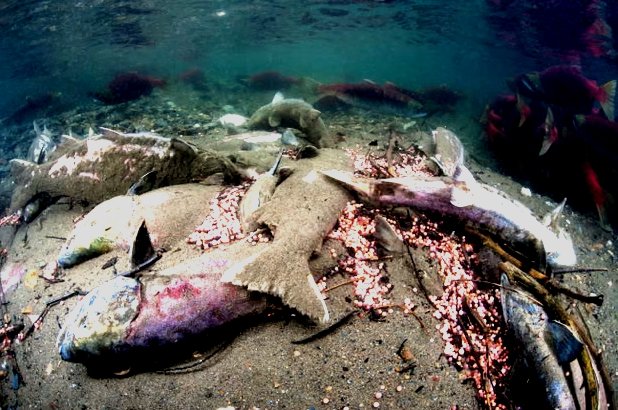
As salmon die after spawning, their carcasses drift downstream and collect in specific areas—deep pools, log jams, slower eddies. Rainbow trout congregate in these “meat lockers,” feeding on decomposing salmon flesh. A pool that was empty two days ago can suddenly hold dozens of large rainbows if dead salmon have washed into it.
This creates a fascinating week-to-week puzzle. Guides in Alaska spend their days constantly scouting, looking for fresh spawning activity and carcass accumulations. A “hot spot” from last week may be dead this week if the salmon have finished spawning and moved on. Conversely, a section that produced nothing yesterday might be loaded today.
Contrast with Traditional Waters
This dynamic is completely foreign to anglers from non-salmon systems. On a Montana spring creek, that 22-inch brown trout lives in the same undercut bank all season. You can target that specific fish day after day. In Alaska, the 30-inch rainbow you caught on Monday might be five miles upstream by Friday, following a fresh push of spawning chums.
This mobility requires a different mindset. You’re not learning “the spots” in a traditional sense. You’re learning to read salmon activity—looking for fresh carcasses, watching for spawning fish, checking tributaries for new runs. The river is constantly changing, and the rainbow trout are constantly responding to those changes.
Behavioral Differences: Aggression and Opportunism
Rainbow trout in spring creeks and tailwaters can be notoriously selective, refusing perfectly good flies over minor imperfections in presentation. They sip insects delicately from the surface and spook at the slightest disturbance.
Alaska rainbows during salmon runs behave like apex predators. They’ve been observed attacking flesh flies with such violence that they hook themselves. They compete aggressively with other trout for prime feeding positions behind spawning salmon. The same fish that might refuse a size 20 midge in Montana will absolutely crush a 3-inch-long sculpin pattern or mouse fly in Alaska.
This aggression stems from the ephemeral nature of the salmon bounty. The trout know, on some instinctive level, that this abundance won’t last. They feed with urgency, packing on as much weight as possible before the long, lean winter.
Techniques: Matching the Salmon Cycle
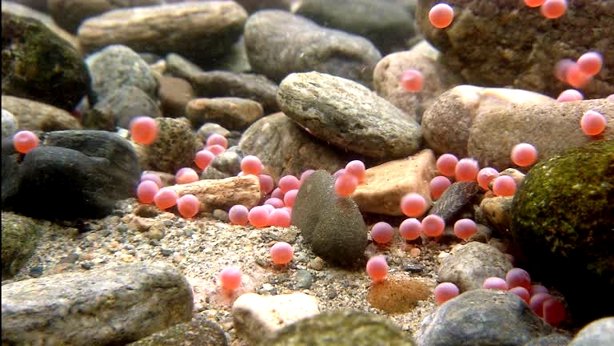
In non-salmon waters, anglers focus on matching the hatch, presenting dry flies or nymphs that imitate local insects. Technical presentations with long, fine leaders are standard.
Alaska rainbow fishing demands a different toolkit. Egg patterns dominate during spawn periods—simple, bright flies in pink, orange, and red that imitate loose salmon eggs. Flesh flies, which look like strips of bloody meat, become effective as salmon begin dying. Large streamers imitating juvenile salmon, sculpin, or mice are standard in the Alaska rainbow arsenal.
The Fly Box Comparison: Insects vs. Salmon
The contrast between a typical Western trout fly box and an Alaska rainbow box tells the story perfectly.
Traditional Trout Fly Box Contents:
- Pale Morning Duns, sizes 16-18
- Blue Winged Olives, sizes 18-20
- Caddis pupae and emergers, sizes 14-16
- Pheasant Tail and Hare’s Ear nymphs, sizes 16-18
- Midge patterns, sizes 20-22
- Delicate dry flies with precise proportions
Alaska Rainbow Fly Box Contents:
- Glo-Bugs and Egg-Sucking Leeches, sizes 6-10
- Flesh Flies (Bunny Leeches, Clouser Flesh Flies), sizes 2-6
- Dolly Llama and Circus Peanut flesh patterns
- Sculpin streamers and Woolly Buggers, sizes 2-6
- Mouse patterns for aggressive surface strikes
- Smolt imitations (Dolly Varden fry, juvenile sockeye)

Notice something? The Alaska box barely contains anything that looks like an insect imitation. The few “nymphs” that work—like rubberleg stoneflies or large bead-head patterns—succeed not because they imitate stoneflies, but because rainbows mistake them for salmon eggs or small leeches.
When Insect Patterns Actually Work
There are brief windows when traditional insect patterns remain effective in Alaska:
Early June: Before salmon arrive, large stonefly nymphs (sizes 4-8) and attractor dry flies work well. But even here, guides are typically using Pat’s Rubberlegs in bright colors (pink, orange, chartreuse)—patterns that blur the line between stonefly imitations and egg imitations.
Between Salmon Waves: Occasionally there’s a lull between species runs—perhaps sockeye have finished but pinks haven’t arrived yet. During these brief periods, rainbows may key on caddis or mayflies again. But these windows are measured in days, not weeks, and guides familiar with the salmon calendar know they’re temporary.
Small Tributaries Early Season: Some tiny feeder creeks don’t host salmon spawning but receive rainbows moving through. In these streams, traditional attractor patterns like Royal Wulffs or Stimulators can work, though larger, meatier patterns still tend to outfish delicate insect imitations.
Why Salmon Patterns Dominate Even During Hatches
Here’s the most telling observation: even when you can see caddis hatching and an occasional trout rising to insects, egg patterns and flesh flies will still outfish the insect imitations ten to one.
Experienced Alaska guides have tested this repeatedly. During evening caddis hatches in August, when logic suggests matching the hatch would be effective, an angler stripping a flesh fly through the same water will hook substantially more fish, and substantially larger fish, than someone dead-drifting a size 14 Elk Hair Caddis.
The reason is simple: rainbow trout in these systems are hardwired to prioritize high-calorie foods. Insects represent snacks. Salmon eggs and flesh represent meals. Even when insects are available and actively being eaten by some fish, the majority of feeding activity remains focused on salmon-related foods.
It’s the difference between eating appetizers at a buffet when prime rib is available. Some diners might pick at the crackers, but everyone’s loading up their plates with the main course.
Presentation matters, but not in the same way. Rather than dead-drifting tiny nymphs, anglers swing large flies through runs, strip streamers aggressively, or high-stick egg patterns through the seams behind spawning salmon. The techniques are more akin to steelhead fishing than traditional trout fishing.
The Ecosystem Effect
Perhaps the most profound difference isn’t visible from the surface. In salmon systems, everything—from water chemistry to predator populations to aquatic insect diversity—is shaped by the annual salmon runs. The nutrients from decomposing salmon fertilize the entire food web. Studies have found salmon-derived nitrogen in trees growing 50 feet from the river.
Rainbow trout in these systems don’t just benefit from eating salmon eggs; they benefit from living in a supercharged ecosystem that produces more insects, more forage fish, and more of everything. Even during periods when salmon aren’t present, the residual effects of the previous year’s run continue to influence the fishery.
The Insect Paradox
This creates a fascinating paradox: Alaska’s salmon rivers actually produce MORE aquatic insects than comparable salmon-free streams, yet insect-imitating fly patterns are LESS important to fishing success.
The marine-derived nutrients from salmon carcasses spike the productivity of the entire aquatic food web. Periphyton (algae) growth explodes, providing food for mayfly and caddis larvae. Decomposing salmon tissue directly feeds some aquatic invertebrates. The result is that Alaska’s rivers can be teeming with aquatic insect life.
But this abundance exists in the shadow of an even greater abundance: millions of salmon eggs, tons of salmon flesh, and the baitfish that swarm to feed on both. The insects are there, sometimes in impressive numbers, but they’re simply outcompeted for the rainbow trout’s attention by foods that provide ten times the calories for the effort.
Entomologists studying Alaska’s rivers marvel at the diversity and density of aquatic insects. Anglers, meanwhile, leave their careful insect imitations in the box and tie on egg patterns. Both observations are correct—they’re just measuring different things.
Why It Matters to Anglers
Understanding these differences changes how you fish. If you approach Alaska rainbow trout waters with spring creek tactics, you’ll catch fish, but you’ll miss the essence of what makes this fishery special. The magic of Alaska rainbow fishing lies in matching your approach to the salmon-driven rhythms of the ecosystem.
When you strip a flesh fly through a run filled with decaying chum salmon and feel the violent strike of a 10-pound rainbow, you’re not just catching a larger version of trout from back home. You’re participating in one of the most remarkable ecological phenomena in freshwater fishing—a system where ocean nutrients, delivered by salmon, create rainbow trout that behave less like delicate sippers and more like the aggressive predators they truly are.
For anglers willing to adapt their thinking, Alaska’s salmon-fueled rainbow trout fishery offers not just bigger fish, but a fundamentally different and thrilling way to pursue these magnificent gamefish.
Float Trips vs. Lodge-Based Fishing: Matching Strategy to the Salmon Effect
Given everything we’ve discussed about the mobile, salmon-following nature of Alaska rainbows, the question of how to fish these systems becomes crucial. Should you book a week at a lodge, or invest in a multi-day float trip? The answer lies in understanding how each approach aligns with the dynamic nature of this fishery.
The Float Trip Advantage: Mobility Matches the Fish
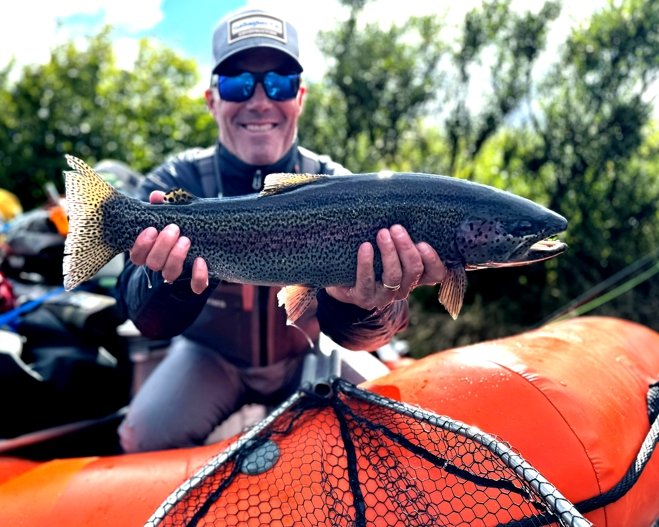
Float trips—where you drift downstream in rafts over multiple days, camping along the river—are arguably the ideal way to experience Alaska rainbow fishing precisely because of the factors described in this article.
When rainbow trout are constantly relocating to follow salmon activity, being mobile yourself is a massive advantage. On a float trip, you’re covering 10 to 20 miles of river per day. You’re not hoping the fish come to you; you’re going to where the fish are right now.
If sockeye are spawning heavily in a particular stretch on day three of your float, you fish it hard. If a massive concentration of dead chums has created a feeding frenzy in a pool on day five, you’re there for it. If spawning silvers have pushed into a tiny side creek on day six, you can pull over and explore it.
The float trip model also lets you experience the full spectrum of salmon-influenced habitat. You’ll fish the main stem runs where sockeye spawn, the side channels where pinks congregate, the tributary mouths where silvers stage, and the deep pools where carcasses accumulate. Because rainbows use all these areas at different times, seeing all of them dramatically increases your chances of connecting with the best action.
Perhaps most importantly, float trips naturally align with the temporal nature of the fishery. You’re fishing during a specific window—say, September 8-15—when certain salmon species are doing certain things. Your trip moves through space as the week progresses, but you’re also moving through time in the salmon cycle, intercepting different opportunities as they develop.
Wilderness Glamping: Float Trips Without Sacrifice
It’s worth noting that “float trip camping” no longer means suffering through cold, cramped tents and sleeping on the ground. Operations like Alaska Rainbow Adventures (floatfishalaska.com and akrainbow.com) have elevated the float trip experience to what they aptly call “wilderness glamping”—the highest quality camping experience available in Alaska.
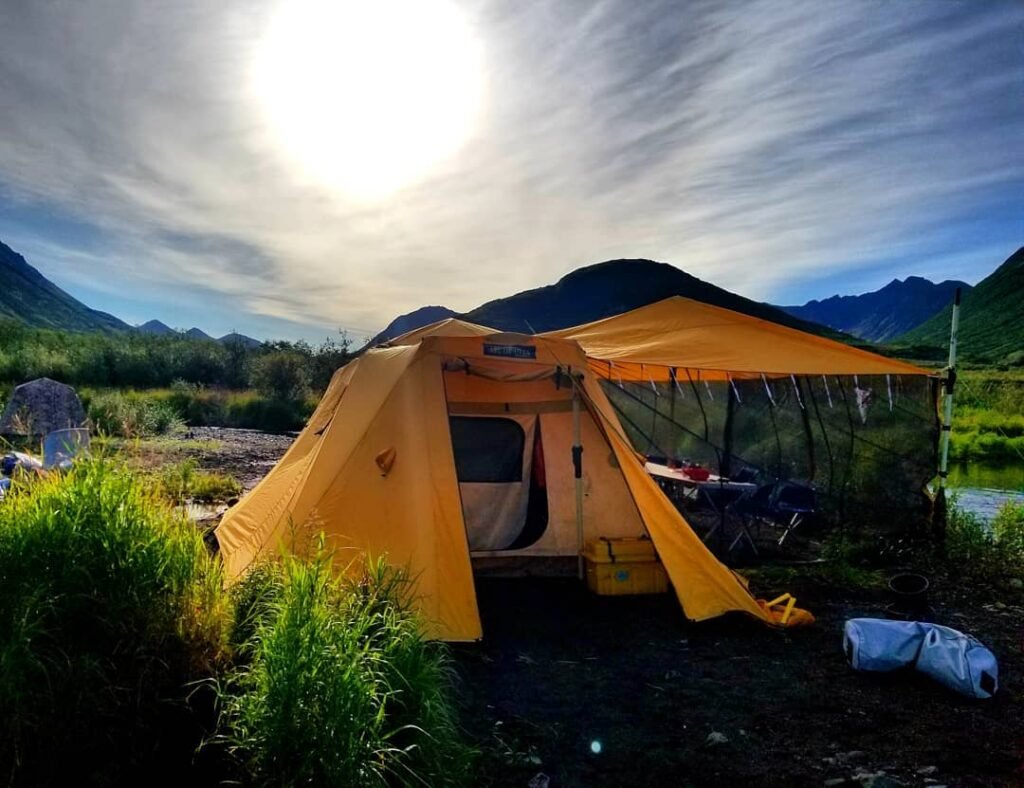
With over 30 years on Southwest Alaska rivers, they pioneered the use of premium Alaskan-made Arctic Oven tents on float trips more than a decade ago. These aren’t boy scout tents—they’re spacious enough to stand up in, equipped with comfortable cots and camp chairs, and built specifically for Alaska’s unpredictable weather. After a long day chasing rainbows, you return to camp where guides handle meal preparation while you relax with a drink and share stories. The 2:1 guest-to-guide ratio means every detail is managed, freeing you to focus entirely on the fishing and wilderness experience.
Their exclusive floatplane access to rivers like the Kanektok, Goodnews, Alagnak, Arolik, and Moraine Creek—many accessed through limited USFWS permits—ensures you’re fishing uncrowded waters at their absolute prime. The custom-built rafts are designed specifically for Southwest Alaska float fishing, and the intimate group sizes mean you’re never competing for water or attention.
This level of quality addresses the main hesitation many anglers have about float trips: the camping. When done right, you get the mobility and immersion that makes float fishing perfect for following salmon-driven rainbows, without sacrificing comfort or dealing with logistical headaches.
The Lodge Reality: Location Becomes Critical
Lodge-based fishing can certainly be productive, but it comes with limitations in this dynamic system. You’re essentially fishing the same 5 to 15 miles of river for your entire stay, hoping the salmon activity and rainbow concentrations happen in that specific section during your specific dates.
When it works, it works beautifully. Some lodges are positioned on stretches that reliably produce throughout the season. But you’re at the mercy of timing. If the sockeye run is late and they haven’t reached your lodge’s water yet, you might miss the egg bite entirely. If the peak spawning action is happening 10 miles upstream where you can’t access it, you’ll catch fish but miss the truly epic moments.
Better lodges mitigate this through variety—they have boats that can run you up and down river, access to multiple tributaries, or even float planes that can move you to different river systems. These lodges function more like mobile operations and can adapt to where the action is. But you’re paying premium prices for that flexibility.
The lodge experience also tends to create a less intimate understanding of the river. You fish sections in the morning, return for lunch, fish again in the afternoon, and sleep in a bed. You’re not living on the river, watching how the salmon activity changes overnight, or stumbling on a fresh carcass drift early in the morning.
Week-to-Week Variables Favor Mobility
Remember that the article emphasizes how things change week to week, even day to day. A lodge that received glowing reports from guests who fished September 1-7 might disappoint guests arriving September 8-14 if the salmon runs have shifted. The same lodge might be spectacular again September 15-21 when a new wave arrives.
Float trips sidestep this problem by moving you through the system. You’re not waiting for fish to come to a fixed location; you’re going where they are. If the guide community reports that rainbows are stacked in a section 30 miles downstream, your float trip will reach that section. A lodge 30 miles upstream cannot.
The Ideal Approach
For anglers who truly want to experience Alaska rainbow fishing the way it’s meant to be experienced—following the salmon, adapting to changing conditions, and covering the full diversity of habitat—float trips are hard to beat. They’re more rugged, require sleeping in tents, and demand flexibility, but they match the nature of the fishery perfectly.
Lodges work best for anglers who prioritize comfort, want a more relaxed pace, or are fishing systems where the lodge’s specific location reliably produces during their travel dates. They’re also excellent for families or mixed groups where not everyone wants to commit to camping.
But if you’ve read this article and felt excitement about the dynamic, salmon-driven nature of Alaska rainbow trout, if you want to chase the fish rather than wait for them, a float trip is the purest expression of how this fishery works. You become part of the system’s rhythm—mobile, opportunistic, and following the abundance just like the rainbow trout themselves.
Alaska Rainbow Adventures can be reached at www.akrainbow.com / floatfishalaska.com and by email at info@akrainbow.com / Telephone 907-357-0251



This is such an interesting breakdown of how salmon shape the entire trout ecosystem. It’s wild toBlog comment creation think how much the nutrient cycle from salmon runs impacts not just trout behavior, but also their size and aggression. It really drives home how interconnected everything in Alaska’s rivers truly is—makes you look at the whole system, not just the fish you’re targeting.
Thank you for your comment: I actually just saw it as I was coming to the site to update it I realized I hadn’t addressed something that surprises a lot of visiting anglers: Alaska’s rivers actually have excellent aquatic insect populations. Caddis, stoneflies, mayflies, midges—they’re all here, and in many cases, more abundant than in comparable streams down south because the nutrient boost from decomposing salmon supercharges the entire food web.
But here’s the fascinating part: despite this abundance, insect patterns become almost irrelevant during most of the season. It’s not that the bugs aren’t there—they’re just utterly overshadowed by the sheer caloric density of salmon eggs and flesh. A rainbow can eat hundreds of salmon eggs in an hour, each one providing far more nutrition than dozens of mayflies. From a survival standpoint, the choice is obvious.
I added a whole section about this “insect paradox”—how the same rivers that entomologists marvel at for their insect diversity are places where anglers leave their carefully matched dry flies in the box and tie on egg patterns. The insects are there; they’re just background noise compared to the symphony of salmon.
It’s a perfect example of what you mentioned—looking at the whole system rather than isolated parts.
Again, Thanks for reading and taking the time to comment!
Paul Hansen / Alaska Rainbow Adventures